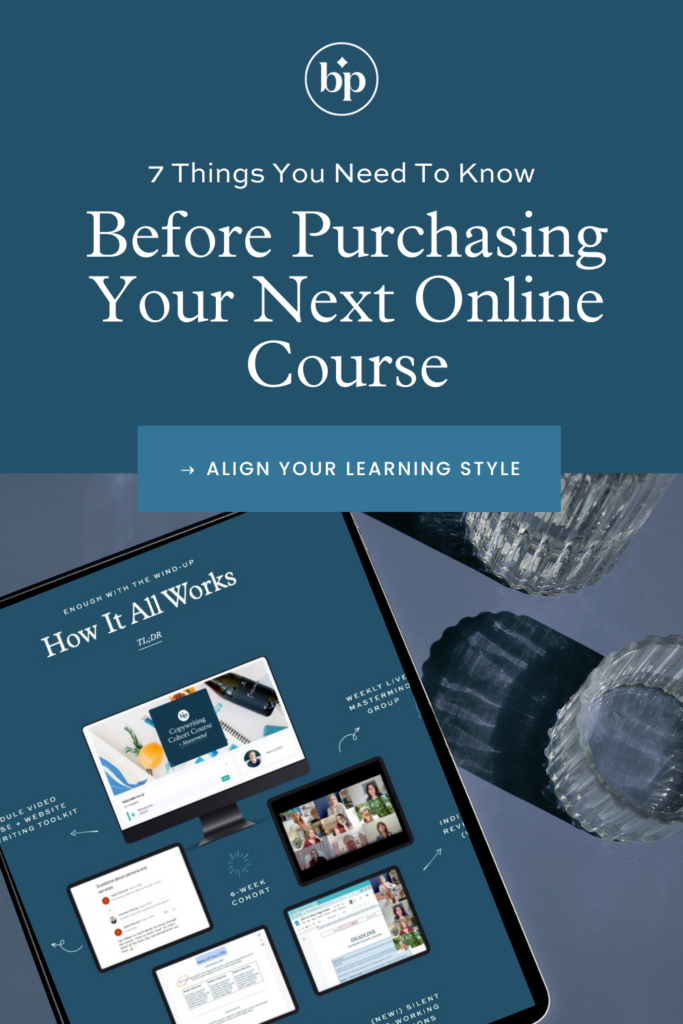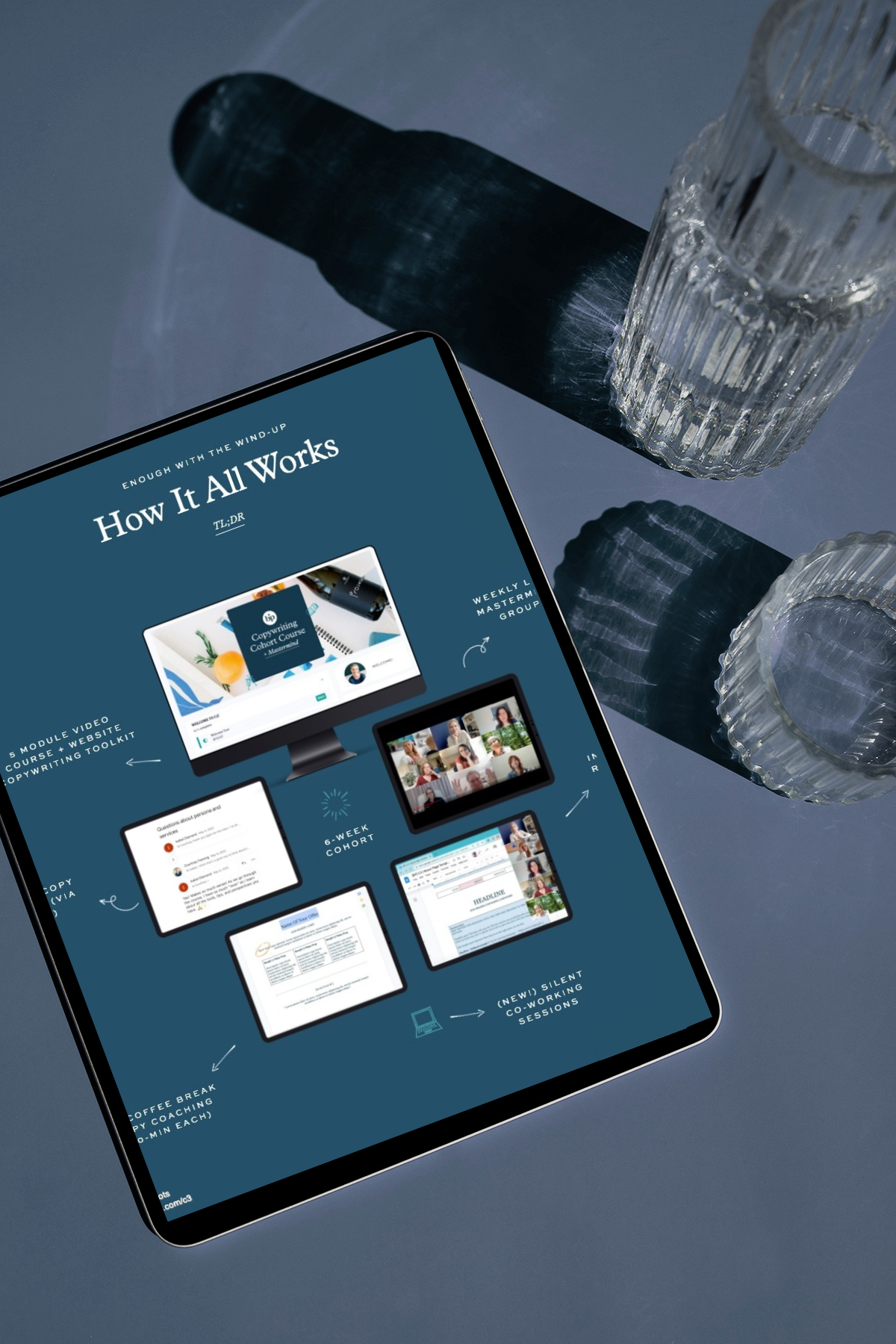It seems like everyone and their mom has a digital course these days thanks to promises of passive income, replacing your 1:1 client revenue, or FOMO.
As someone who has enrolled in live courses and purchased passive ones, I have a lot of opinions about why most courses suck.
The two biggest issues with online courses are:
- Most people don’t know how to teach
- A lot of courses lack integrity
It is my opinion that most courses are motivated by the desire to make a buck, rather than to help people solve a problem honestly.
When you’re motivated by money, you start thinking about your course’s value in terms of dollars per deliverable.
We’ve all seen the “Marketing Receipt”: These templates are worth $497, and the coaching is worth $1,000 = $1,497 but I’m offering it for $19, buy now!*
Instead, we should be thinking about the value to the student.
That’s the integrity piece—so what about the teaching bit?
The reason my course is done as a cohort with a live mastermind, as well as 1:1 coffee chats, hands-on editing by moi, and optional silent co-working sessions, is that…
…passive courses are a sh*tty way to learn something that doesn’t come naturally to you. (Or that you don’t feel confident about.)
Can you imagine taking Calculus as a passive online course?
Pretty sure the data is in and we learned a lot about online learning during COVID. (Spoiler: It’s not great.)
My kids are four and six and their teachers spend an inordinate amount of time adapting their curriculum to suit the learning styles of their students.
Some people learn better through hands-on activities, others prefer visual aids, and some need auditory instruction.
How you learn best is a really important thing to consider BEFORE you purchase a course, join a membership, or sign up for coaching.
The best course I ever took was Shanna Skidmore’s Blueprint Model. Numbers aren’t exactly my thing so the fact that Shanna sat down and reviewed my work each week and told me exactly what to fix made the course work for my brain *AND* I walked away knowing how much I could afford to pay myself and my taxes.
Understanding how you learn best is especially important if you’re a neurodivergent learner, manage ADHD, or have a lot going on at home because:
- The act of purchasing a course isn’t going to fix your problem.
- You are the one who has to put in the majority of the work—not the course creator—even if it doesn’t work for your brain.
- It’s not the course creator’s fault if you don’t complete the course.
As a responsible course consumer, you need a set of standards that must be met before investing in your next three-to-five-figure purchase.
*P.S. I’m not knocking the practice of price anchoring to communicate value. You have my permission to use a Marketing Receipt. Just don’t bloat your deliverables to inflate your price.
Don’t Buy An Online Course Before Considering These 7 Things
1) Does the course offer multiple ways to consume the content?
Is there a mix of live content, independent work (worksheets etc.), group work, video, and audio? Are there interactive activities that can help you grasp different concepts, like quizzes, hot-seats, games, role-playing, debates, or journaling/self-reflection work?
2) Is the course laid out in an intuitive and organized way?
Everyone thrives when basic structures are put in place. Does one module build off of what you learned in the last one, or does the order of operations feel like they were drawn out of a hat? When things are organized, and predictable, and the course materials look and feel consistent, our brains can focus on the information instead of how it’s delivered.
An example of this is that every module of the Copywriting Cohort Course + Mastermind begins with an introductory video giving you some context for what you’re about to learn and why. Under the video is a bulleted list of instructions (e.g. watch this, download this, start writing this, attend this meeting with this link) which takes the same format every week. This way my students always know where they can go to find everything they need for the week. The format never changes.
3) Can the lessons be completed in small, digestible chunks?
Most learners do not have the capacity or attention span to focus on a single topic for more than 10-15 minutes at a time. If the module covers a lot of ground, it should be broken down into smaller parts so you can process the information you just learned.
4) Does the course set reasonable goals and expectations?
Be wary of a course that promises to change your life overnight. If it sounds too good to be true, it is. Another way a course sets you up to fail is by expecting you to do the work of ten people on your own. This can play out by packing a course with bonuses and a million extras. This not only bloats the value of the course, it sets unreasonable expectations for how much work you’ll be able to realistically complete on your own without making the course your second (or third) full-time job.
5) Does the course offer a safe space for you to ask questions?
Maintaining psychological safety isn’t for the woke—it’s a really important indicator for whether or not a course has the potential to deliver results. While taking a course you’ll undoubtedly have a question or feel stumped by something. If there isn’t a way for you to get the answer to your question directly from the course creator, that one tiny roadblock can be all you need to lose confidence and stop doing your coursework.
Not having a place to ask questions is one issue, but another can be not feeling safe enough to raise your hand in the first place, contribute an idea, or say, “You’ve lost me. Can you explain that in a different way?”
If the course creator is inaccessible (and doesn’t provide any avenues to connect 1:1) or an intimidating figurehead, you might consider purchasing a course from a creator who provides a learning environment that better aligns with your needs.
6) Does the course offer “scaffolding”?
The problem with learning from an expert is they can forget that it took them years and years to construct the neural “scaffolding” in their brains that holds up and connects all the ideas and information you’re learning for the first time. It’s like trying to teach a child their multiplication tables before they’ve learned addition.
Course scaffolding can look like templates or preparation materials. For example, in addition to gaining access to the BP website copywriting templates, Copy Cohort students spend two weeks before our first mastermind and implementation week, gathering testimonials, sending out surveys, and performing audience research. Each week’s video is paired with an exercise that requires them to go back to their original research and pluck out the information they now know, and need.
We’re constantly connecting new information with the old to create the scaffolding we need to build a website and write the copy.
7) How will the course pull you along?
If the course is live, will you receive consistent communications such as due date reminders, meeting links, and direct links to work you should complete according to the course’s timeline? If the course is passive, will you receive weekly emails encouraging you along the way, making it harder for you to abandon it altogether?
Conclusion
There are of course other factors to consider beyond learning style and support systems. Budget is the obvious one, but time is the underrated currency most people don’t consider when committing to a course. Just because a course can be done “on your own time” doesn’t magically increase the number of hours you have available in a day. So the next time you’re feeling pulled to purchase a course, ask yourself if now is the best time in your life, if it’s a sound financial investment (not an impulse buy brought on by a compelling sales page–I know, I’ve written many, and the irony is thick) and if the course is built in a way that works for your brain.
PIN TO SAVE FOR LATER

❤️ This Blog Is Reader-Supported.
If you find my articles & free resources helpful…
THE BP RESOURCE LIBRARY STARTED AS A WAY TO OFFER BRAND STRATEGY AND COPYWRITING EDUCATION TO CREATIVES AND ENTREPRENEURS WITH CHAMPAGNE TASTES BUT A PELLEGRINO BUDGET.
If I’m helping you make more sense of this whole “writing for your biz” thing, please consider expressing your appreciation for the research, writing, and design that goes into each and every post and library freebie.
HELP SUPPORT THIS CONTENT.
